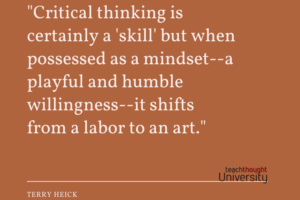
The Basics of Making a Curriculum for Homeschool Students
7.7K
Homeschooling offers a unique opportunity to tailor your child’s education to their specific needs and interests. You become their biggest advocate as they grow in subjects like math, science, and English. Making a curriculum for homeschool students that’s engaging and tailored to their learning style is key to helping them succeed. Keep things simple by following this step-by-step guide to building effective lessons. Creating a year-long curriculum for your learners from scratch is no easy task. Enter TPT — a place where you can turn for fresh ideas, resources, and tips from experienced educators.
1. Start with core concepts
Build a solid foundation for lifelong learning by starting with core concepts. Introduce core subjects, like math, English, science, and social studies, through play, creativity, and real-world experiences. Look for a curriculum for each of those subjects, and let your student’s interests guide your lessons.
Preschool: Full Year Curriculum {Plans and Printables} BUNDLE
By Mrs Plemons Kindergarten
Grades: PreK-K
This bundle focuses on exposure to core subjects with summary pages, printables, and activity overviews. Every activity can be used with one or more students.
Preschool Curriculum & Lesson Plans | Toddler Activities Worksheets Sensory Bins
By The Stay at Home Teacher – Kaitlyn Renfro
Grades: PreK
This curriculum includes basic skills like counting, shapes, colors, letter identification, and more. It also comes with monthly activities and printables focused on fine motor skills like writing and coloring.
2. Block out time for reading and writing
Reading and writing are core components of any strong homeschool curriculum. Use standards specific to your state, like Common Core State Standards, to choose materials that match your child’s grade level.
A good program should cover phonics, grammar, spelling, reading, and composition. Look for diverse curricula that offer a mix of games, writing prompts, hands-on activities, and real-world applications. A great ELA curriculum doesn’t just teach mechanics; it lifts the veil to a powerful and enchanting world of language.
Kindergarten Writing Personal Narrative, Opinion, How To, Prompts, Paper, Poetry
By The Moffat Girls
Grades: K
Standards: CCSS W.K.1, CCSS W.K.2, CCSS W.K.3
Seven writing units cover realistic fiction, opinion and persuasive writing, and poetry. This program also offers students foundational research, planning, writing, and revising skills.
4th Grade Reading Comprehension Passages & Daily Questions: Fiction & Nonfiction
By One Stop Teacher Shop
Grades: 4th
Standards: CCSS RL.4.1, CCSS RL.4.2, CCSS RL.4.3
This resource is perfect for a daily reading review activity. All texts are professionally written and on-level, and all questions are editable, which makes it easy to customize them to fit your student’s needs.
9th Grade English ELA Curriculum Bundle for a Full Year, 15 Units & Lesson Plans
By Love and Let Lit
Grades: 9th
Standards: CCSS RL.9-10.1, CCSS RL.9-10.2, CCSS RL.9-10.3
This curriculum bundle features 38 weeks of curriculum in 15 complete unit plans. Students study six novels, learn to write multiple essay formats, write and study poetry, and learn discussion skills.
3. Make math hands-on and incorporate vertical learning
Math curriculum should strike a balance between explaining the why behind math and offering plenty of practice with the how, while following education standards for your area. Some curricula follow a mastery approach (diving deep into one concept at a time). Others use a spiral approach, revisiting topics in smaller chunks.
Your student’s learning style can help you decide which method works best for making a personalized curriculum. Don’t be afraid to think outside the math book; real-world applications and hands-on activities can improve engagement in important topics like financial literacy.
Second Grade Math Curriculum Bundle
By Tara West – Little Minds at Work
Grades: 1st-2nd
Math couldn’t be easier with this 30-week program designed to cover 60-minute math blocks. It includes 150 premade lessons and a hands-on approach with partner work, discussions, and games.
7th Grade Math Curriculum Scaffolded Guided Notes and Activities
By The Sassy Math Teacher
Grades: 7th-8th
This math curriculum is bursting with notes and activities that will prepare your students for pre-algebra. The notes are easy to follow and student-friendly, while the activities are engaging.
Consumer Math – Financial Literacy – Personal Finance Curriculum BUNDLE
By Apples and Bananas Education
Grades: 9th-12th
This resource is perfect for a consumer math, personal finance, lifestyle math, or life skills course. It offers a digital and printable version with notes, lesson extensions, presentations, quizzes, and a real-world project.
4. Design exploratory science activities
When it comes to making a curriculum for homeschool students, science should spark curiosity, not just check boxes. Start by looking at the Next Generation Science Standards (NGSS), which go beyond memorization to emphasize real scientific thinking, like asking questions, analyzing data, and spotting patterns across topics.
Consider whether you’d rather cover lots of topics or dive deep fewer concepts. For example, a simple unit on insects can turn into weeks of bug hunts and mini lab reports. And don’t forget: Science is everywhere. Find ways to connect it to your family’s culture, traditions, and everyday life.
Little Learners Science BUNDLE (for preschool, pre-k, and kinder)
By Pocket of Preschool – Jackie Kops
Grades: PreK -K
Using this curriculum, you can make science fun and hands-on. Over 1,500 pages include 25 units covering trees, space, magnets, ramps, habitats, and the scientific method.
Environmental Science Curriculum – Full Year of Lesson Plans, Labs, and Tests
By Suburban Science
Grades: 10th-11th
Standards: NGSS HS-ESS2-5, 2-3, 2-4
This comprehensive course is interactive, hands-on, and student-centered. Students learn about major environmental issues in modern society through detailed lessons and activities. Units cover the four spheres of the Earth (lithosphere, hydrosphere, atmosphere, biosphere).
5. Introduce social studies experiences
According to the C3 Framework, a strong curriculum should include civics, economics, geography, and history, with plenty of space for diverse cultures and perspectives. Seek programs that go beyond storytelling to build critical thinking and analysis skills.
The best social studies lessons are active, incorporating role-playing, map work, hands-on projects, and field trips. And if the curriculum weaves in reading, writing, or art, even better. Learning is never one-dimensional, and social studies shouldn’t be either.
Little 1st grade Social Studies Thinkers YEAR-LONG CURRICULUM
By Karen Jones
Grades: 1st
This bundle aligns young learners with responsible citizenship, history, community, and geography through five full unit plans and two mini-units. It includes teaching guides, printables, lesson plans, anchor charts, and student workbooks.
U.S. History Curriculum – American History Curriculum – Full Year – Google Drive
By Morgan AP Teaching
Grades: 8th-11th
Standards: CCSS RH.11-12.1, 12.2, 12.4
Go digital with this Google Drive living bundle that includes a pacing calculator, daily lessons, 250+ activities, and deep dives. You can also access edible PowerPoints, graphic organizers, and research projects.
6. Nurture creativity with the arts
Art expression is about building skills, exploring creativity, and connecting with the world. A strong homeschool art curriculum introduces artists, styles, and techniques while encouraging experimentation. Try aligning your art curriculum with National Core Arts Standards, which focus on creating, presenting, responding, and connecting.
Experiment with tying art into other subjects with math art projects, science diagrams or displays, or visual history projects. Art and music are the perfect place to blend expression with education when making a curriculum for homeschool students.
Elementary Music Lesson Plans-Set #2 (K-5 Curriculum Companion)
By Emily Conroy
Grades: K-5th
You’ll find music lesson plans, “lessons at a glance,” original songs (with sound files), and pages of additional resources for K-5 music students. The lessons meet the National Core Arts Music Standards.
Introduction to Art Curriculum, Art Projects for Middle School, High School Art
By Look Between the Lines
Grades: 6th-12th
This art curriculum bundle pack includes lessons, worksheets, art projects, and more to fill every day of a school year (it can also be trimmed down to a semester-long course). All you need are the art-making supplies, and you are set for the year.
7. Keep social and emotional learning in mind
Making a curriculum for homeschool students goes beyond core subjects to include social and emotional learning (SEL), especially since homeschool students often learn independently. Work to find a curriculum that supports mental well-being, encourages empathy, and helps students build positive relationships.
Include lessons focusing on self-regulation, decision-making, and developing a growth mindset. These SEL skills help prepare kids for real-world challenges and meaningful relationships when paired with outings and meetups with other students.
Social Emotional Learning Activities, Social Skills, Kindness SEL Curriculum K-2
By Proud to Be Primary
Grades: PreK-3rd
Standards: CCSS SL.K.1, 1a, 1b
Teach important character education lessons with social-emotional learning activities, worksheets, and lesson plans on emotions, self-regulation, growth mindset, empathy, friendship, kindness, responsibility, and respect. This bundle includes eight units and over 40 lessons, including discussion cards, interactive charts, and crafts.
8. Choose resources that fit your style and family
Homeschooling is a personal choice that opens the door to a wide range of curriculum options. Along with choosing subjects, think about a curriculum that fits your teaching style, family schedule, and educational values. It’s also essential to consider your student’s unique needs.
Trying different options can help you find what truly fits and ensure you agree with the assessment style. Take into consideration timing as well. Are you looking for summer teaching resources or something for your students year-round?
Tips for Making a Curriculum for Homeschool Students
Building a successful homeschool curriculum happens one thoughtful step at a time. But looking over all the different curricula available and understanding how to use TPT for your homeschool curriculum can help you take the first steps.
- Plan Ahead: Homeschooling is a big commitment, and with a well-thought-out plan, you can set your student up for success from the start.
- Start with Your Goals: Define what you want your student to learn and how you want them to learn it. Writing down your goals and their goals can help you stay focused and organized.
- Use State and National Standards as a Guide: Review your state’s education standards or national benchmarks to help choose age-appropriate materials and track essential skills.
- Consider Your Student’s Learning Style: Every learner is unique. Take time to understand how your student learns best and choose resources that support that style.
- Incorporate Real-World Experiences: Learning can happen anywhere. A walk in the park, a trip to the store, or baking at home can become meaningful, hands-on learning moments.
- Make Your Teaching Style Shine: Choose resources that fit your personality and strengths as an educator. A curriculum should work for both you and your student.
- Mix It Up: Keep your student engaged by blending books, games, online tools, crafts, and hands-on projects. Variety can also help learning stick.
- Use Themes: Organize your lessons around themes to create cross-curricular connections and make learning more cohesive.
- Consider Your Budget: Curricula can get expensive. Look for free or affordable homeschool curriculum resources, reuse materials when possible, and take advantage of affordable platforms, like TPT.
Benefits of Using TPT to Plan Your Homeschooling Curriculum
Making a curriculum for homeschool students from scratch can sometimes feel like hiking a mountain. But you don’t need to start from scratch because TPT has dozens of homeschool curriculum resources. And they offer you the advantage with:
- Diverse Resources: Whether you’re teaching math, science, or history, you’ll find resources tailored to your student’s learning style and your teaching preferences.
- Quality and Expertise: The resources are created by experienced professionals who know what works to engage kids.
- Customizable: You can mix and match resources to fit your child’s unique needs for an even more personalized learning experience.
You can’t go wrong when making an easy and affordable homeschool curriculum that’s built from the ground up by professionals in the field.
Source link


















